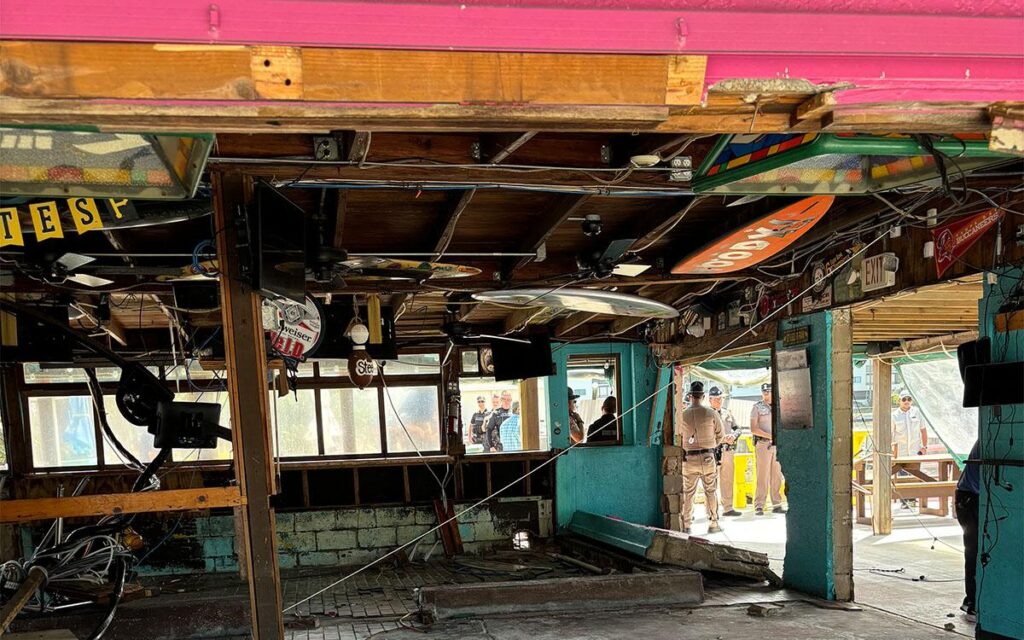A Florida Writer’s Diary as Hurricane Helene Approaches

Photo courtesy of Jack Davis
The Storm Approaches—Wednesday, September 25: Florida’s latest hurricane, Helene, has rapidly intensified into a Category 1 storm. Since its formation, residents have been closely monitoring the National Hurricane Center’s tracking updates.
Hurricanes involve a lot of waiting. With 1,350 miles of coastline, Florida is frequently in their path. Since 1851, 121 hurricanes have impacted the state. The latest tracking shows that Helene, number 122, will likely move north along Florida’s West Coast. Gainesville, where I live, falls within the projected cone.
Local authorities have been proactive. Gainesville announced municipal office closures for Thursday, with essential services remaining available. The University of Florida canceled Thursday classes, with decisions for Friday still pending.
As I bike home after class, I ponder the weekend’s planned 100-mile bike ride celebrating Jimmy Carter’s birthday, scheduled in Plains, Georgia, directly in Helene’s projected path. The organizers have yet to cancel the event.
A brief rainstorm raises questions about whether it’s an early sign of Helene. I run errands, including a grocery store trip where shoppers are stocking up on bottled water. The sight of all the plastic reminds me of the petrochemical industry’s role in environmental challenges and intensifying storms.
Governor Ron DeSantis recently signed legislation removing “climate change” from state laws, despite recent record heats and costly storms. His resilience plan involves hardening the coast with concrete, which is less effective than restoring natural shorelines.
DeSantis’s administration also proposed developing state parks with lodges and golf courses, although public outcry halted these plans.
At home, I prepare for potential power outages. I text Melissa Seixas, Duke Energy’s Florida state president, who is coordinating storm readiness. She tells me they have 6,500 bucket trucks prepared.
Officials in Tampa Bay expect a storm surge similar to Hurricane Ian’s in 2022. Virginia Tech meteorology professor Stephanie Zick explains that Helene, originating from a low-pressure area in the western Caribbean, is larger and likely to push a significant storm surge. The Gulf’s warm waters add moisture, fueling hurricanes.
Zick also warns of potential inland flooding, with heavy rain likely to collide with Helene over Georgia.
“Shopping carts are filled with shrink-wrapped cases of bottled water. All these customers are buying climate-change in a bottle.”
Eve of the Storm—Thursday, September 26: By morning, Gainesville lies outside the strike zone as Helene’s projected path shifts west. However, officials caution against complacency.
Longtime Florida residents can become desensitized to hurricanes. My neighbor dismisses the threat, and a local bakery employee describes herself as desensitized due to growing up in Miami. However, experiences like Hurricane Andrew in 1992 show the potential devastation.
My friend Sandy, a therapist, mentions that her clients never express hurricane concerns. Her teenage daughter loves hurricanes, a sentiment shared by many who enjoy the intense weather, provided it’s not too destructive.
Helene’s path is eerily similar to Hurricane Debby’s, which hit the coast near Gainesville two months earlier. Helene is expected to make landfall in Florida’s Big Bend region.
My thoughts turn to Apalachicola, where friends who are oyster farmers recently recovered from Debby. They moved to Tallahassee for safety. Rain comes and goes, and officials urge evacuations with unprecedented urgency.
Helene strengthens to a Category 3 storm, prompting FEMA to prepare for a multistate event. The University of Florida cancels Friday classes as Gainesville braces for impact.
By 4 pm, power outages affect over 17,000 households and businesses in the Tampa Bay area. The Jimmy Carter bike ride organizers still plan to proceed, despite the hurricane.
Melissa compares the mobilization of resources to “staging an army,” with crews ready for power restoration and clean-up.
Conditions in Gainesville escalate as Helene is upgraded to Category 4. By midnight, Melissa texts, “Tomorrow we go into Mach 4.”
“The construction crane will never be an endangered species in Florida.”
The Storm Arrives—Friday, September 27: At 4 am, Melissa reports ongoing power outages and local flooding. Gainesville largely avoids damage, but some areas are without power.
The Jimmy Carter bike ride in Plains, Georgia, proceeds as planned. However, Helene leaves a trail of destruction, with 26 reported dead in three states and millions without power. Cedar Key is demolished, and inland areas like Tallahassee and Apalachicola face severe impacts.
Driving to Georgia, we see extensive damage along Interstate 75. Utility bucket trucks are everywhere, and gas stations with backup generators are crowded.
“The Gulf’s warmer-than-usual waters mean more moisture in the air, moisture that fuels hurricanes.”
The Storm’s Aftermath—Saturday, September 27: In Americus, Georgia, we start our bike ride under a clear sky. Plains, hosting the Peanut Festival, shows little sign of the hurricane’s recent passage.
My friends in Apalachicola are safe, though they still need to check on their oyster farm. The bike ride is a success, despite fewer participants than planned.
Returning to Florida, we see continued damage and ongoing recovery efforts. Meteorologists are monitoring new weather formations in the Atlantic and Gulf. The old adage about hurricane seasons no longer holds true in the face of climate change.
Original Story at www.sierraclub.org
